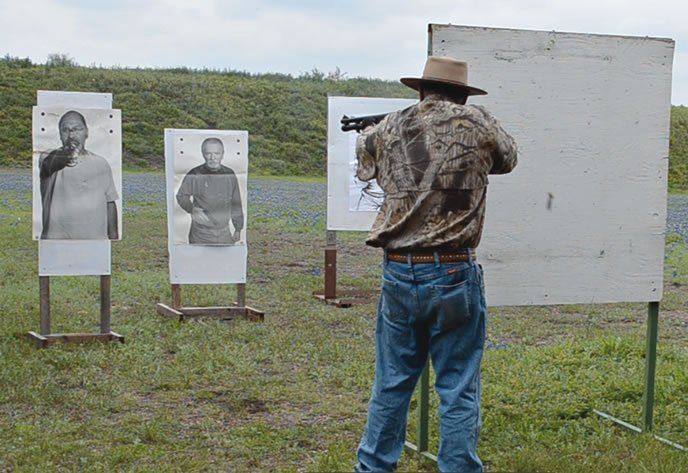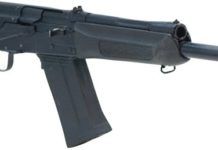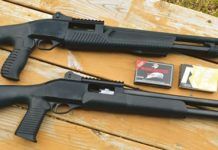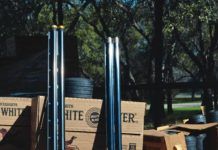There are times when a potential owner of a reliable self-defense shotgun might want to spend a little more money on upgraded features for the sake of comfort or convenience, so we ventured into the world of extra bells and whistles in this test of two higher-end tactical self-defense shotguns. This is the second part of a four-pack of pumps our team put through their paces. For this test we picked a pair of self-defense firearms in the $700 to $775 MSRP range to see how they would stand up to a thorough examination on the shooting range. The 12-gauge shotguns selected for this review were a Mossberg Model 590 Magpul with an adjustable stock listing for $773, and a Tristar TEC-12 capable of either pump action or semiautomatic fire that retails for $689. Both retail for around $500.

While budget is a key factor in the minds of many shooters as they ponder the purchase of a self defense shotgun, there are times when added features are too good to pass up despite the added cost.
Firearm manufacturers are well known for tossing in a few bells and whistles to make their product a little more attractive. The hope is that buyers will be willing to shell out a few dollars more for a feature that will make their new firearm more accurate, more comfortable, more attractive, etc. Sometimes the added features prove to be worth the additional cost, and sometimes the bell or whistle is just eye candy.
As noted in last month’s review of two pump actions, self-defense shotguns fall into a category of rarely used but necessarily reliable firearms. When they are put into play, the shooter should be able to touch off consistently accurate, perfectly functioning rounds in what might be a life or death situation. There is a wide selection of these types of firearms carrying a price tag of $500 or less, most of which are so similar that distinctions in appearance and handling are minor at best.
In this match-up we selected a pair of what we would consider higher-priced shooting tools: The Mossberg Model 590 Magpul was outfitted with a fully adjustable stock and extended magazine retailing for $773. The Tristar TEC-12 was capable of either pump action or semiautomatic shooting, and it is available for $689.
Using the same type of shotgun ammunition that was fired through last month’s shotguns, our test rounds included Rio Royal Buck 2.75-inch loads moving nine pellets of No. 00 buckshot at an average muzzle velocity of 1345 fps, and Winchester Reduced Recoil Winlite 2.75-inch loads pushing 0.9-ounce 400-grain sabot slugs with an average muzzle velocity of 1450 fps. Our function-fire and cycling rounds were Remington ShurShot Heavy Dove 2.75-inch loads with 11⁄8 ounces of No. 6 shot moving at an average of 1255 fps.
For shots in close-defense simulations, we fired test loads at Birchwood Casey Eze-Scorer 23-inch by 35-inch Bad Guy targets and the identically sized Targets Online paper images of potential threats. For slug shots at 25 yards, we used Champion VisiColor Zombies 12-inch by 18-inch Slasher Tusks targets. Only head shots were counted as acceptable results with the slug ammo because that is what Hollywood tells everyone is the way to dispatch a zombie. Here are our findings:

Mossberg Model 590 No. 50669 Magpul Pump-Action 12 Gauge, $773
While expecting a little better quality and performance because of the higher price tag and the fully adjustable stock, we have to admit we were disappointed in just about every aspect of this shotgun. In particular, shoulder shock moved into our home with the first round touched off in the Model 590 and stayed as an unwelcome guest throughout the testing.
The 39.25-inch-long pump had a short, angled grip on the stock that was adjustable for both length of pull and comb height. It also featured an 8-round magazine for increased firepower. After firing several rounds through the pump, none of our test team members had any interest in trying to complete a rapid-fire drill of all nine rounds.
The heft of the Model 590 was considered acceptable, although the shotgun was muzzle heavy even when unloaded, we thought. The empty shotgun weighed right at 7.5 pounds. However, the textured pistol grip and short, ridged forearm did not provide as good or as comfortable a hold as we would have liked.
During the accuracy testing on the zombie hog target set 25 yards downrange, we found that alignment with the adjustable Ghost Ring rear sight and the red ramp sight during the rapid-fire, five-shot group of sabot slugs was very poor. Add in the factor of what we would consider extreme recoil, and we were not surprised when the five-shot group measured 9 inches across and was well below the kill zone. There were no shots in the head and only one that would have resulted in a chest wound.
The short length — just 8 inches — and shape of the forearm made the Mossberg hard to hold during rapid-fire drills, our team said. Although recognizing that the Mossberg did not have a full-length pistol grip like the other shotgun in the test, we were still disappointed in the way the shotgun handled. We thought this despite the fully adjustable stock, which allows a shooter to customize the length of pull and the comb height, an impressive feature rarely found on a self-defense firearm. However, the stock seemed to do little to tame recoil.
Similar unsatisfactory accuracy results were achieved during the close defense situation, wherein three potential threats at less than 7 yards were handled with five shots of No. 00 buckshot. The run with the Mossberg took 5.72 seconds, which was a full second longer than that of the Tristar in either its pump-action or semiautomatic mode. The Mossberg’s first shot was touched off at 1.2 seconds; then 1.82 seconds for the second shot on the same target; 2.64 seconds for the third shot, this one at the second threat; 5.05 seconds for the fourth shot after moving to the other side of a barricade, and 5.72 seconds for the final shot, the latter two at the third target. Videos of these drills will be available soon on the magazine’s YouTube channel.
In addition to the handling problems mentioned earlier that contributed to the longer drill time, one of the nine No. 00 pellets on the second target went wide to the left. By missing the body of the second potential threat, that shot could have easily carried on to strike a bystander or do other unnecessary damage downrange. In addition to the errant pellet, the other buckshot loads struck low on the center mass on the targets, with an average pattern stretching about 9 inches across.
While the Remington No. 6 shotshells used in function-fire and speed-fire testing cycled in an acceptable manner, the shoulder shock problem continued to make firing the Mossberg an uncomfortable experience. On the plus side of the Mossberg review, we were pleased with the 5.5-pound trigger pull that made touching off rounds a little easier. Also, we liked the safety lever on top of the receiver that provided easy access. The extended magazine that allowed the shooter to fire up to nine rounds, should that ever be necessary in either practice or real-life situations, was considered a plus for the Mossberg.
Our Team Said: This Mossberg 590 Magpul was found to be hard to handle and control, particularly since it kicked like a mule — recoil was substantially greater than with any other tactical pump we handled. Accuracy with both the slugs at 25 yards and with the No. 00 buckshot in the self-defense drill was disappointing, our shooters said, and the sights were not as easily aligned as with the other models tested this month and last.
Tristar TEC-12 No. 25120 Pump/Auto 12 Gauge, $689
The ability to fire in either pump-action or semiautomatic mode was the most obvious added feature on this shotgun. We found that transforming the Tristar from a pump action to a semiautomatic was surprisingly simple. A twist of the adjustment ring near the end of the magazine is all that is required for the switch.

Even better, in addition to having quick runs and no functioning problems in either mode with the Tristar, we found the shotgun handled better with less recoil, even in rapid-fire drills.
Also, our shooters noticed that recoil when firing in either mode was also lighter than with any of the other firearms, even with the Tristar weighing in at 7.5 pounds, the same weight as the Mossberg.
In the scenario involving three close-up potential threats, the accuracy of the Tristar impressed our crew. Both runs, one in the pump-action mode and one as a semiautomatic, were quick and solid with excellent center mass hits.
As a pump action, the Tristar run was completed in 4.84 seconds, with the first shot fired at 0.94 seconds; the second at the same target at 1.89 seconds; the third shot on another target at 2.45 seconds; the fourth shot on a third target at 4.24 seconds; and the final shot at the third target stopped the clock at 4.84 seconds.
Switching to semiautomatic mode, the Tristar run was cut down to 4.42 seconds total. The first shot was fired at 1.14 seconds; the second was timed at 1.50 seconds; the third at 2.12 seconds; the fourth at 4.16 seconds; and the final shot was 4.42 seconds.
Although its design and appearance were nearly identical to the other full-length pistol-grip shotguns we tested, the heft and balance were quite nice. Even with a relatively short forearm, measuring just 7 inches long, we liked the feel of the grooved slide action and the rubberized pistol grip. Both provided a secure, firm hold even during the rapid-fire drills.
Measuring just a quarter-inch longer than the Mossberg with an overall length of 39.5 inches, the balance of the shotgun was very nice, we thought. When the weight of a shotgun is balanced, the handling ability is enhanced and moving onto a target is much easier.
On the trip to the range, we found that the adjustable Ghost Ring rear sight and red-bar front sight bracketed by high-rise side plates were easy to align on target. That resulted in exceptional performance on a 25-yard zombie hog target. Firing in pump-action mode, we put five slug shots clustered into a 3-inch group — all in the middle of the kill zone. This was the best group achieved with any of the self-defense firearms in the four-pack test.
We were a little concerned about the 9-pound trigger pull, about 4 pounds heavier than what we prefer in a self-defense shotgun. However, the heavy trigger did not appear to be a detriment to putting quick and effective shots on targets.
Elsewhere, the extended and ported choke tube may have been a factor in our team’s assessment of the Tristar’s reduced recoil. Porting is designed to expel gases from the fired rounds to each side rather than allow all the push to rock back on the shooter’s shoulder. This is another feature we appreciated on the Tristar.
Our Team Said: Offering comparatively light recoil with the heavy loads and good accuracy, the Tristar TEC-12 excelled in our testing. We were pleased with the comfort and handling and the added feature of being able to switch from pump action to semi-automatic quickly and easily.
The only downside we could find was with the trigger pull, and we would recommend getting it adjusted to make the 9-pound tug a little lighter.
When all four tactical pump-action shotguns were tossed into the mix, including the CZ-USA and Weatherby models tested last month, the Tristar TEC-12 rose to the top of our rankings.
Written and photographed by Ralph Winingham, using evaluations from Gun Tests team testers. GT
Tristar TEC-12 No. 25120
Pump/Auto 12 Gauge, $689
The ability to fire in either pump-action or semiautomatic mode was the most obvious added feature on this shotgun. We found that transforming the Tristar from a pump action to a semiautomatic was surprisingly simple. A twist of the adjustment ring near the end of the magazine is all that is required for the switch.
Even better, in addition to having quick runs and no functioning problems in either mode with the Tristar, we found the shotgun handled better with less recoil, even in rapid-fire drills.
Also, our shooters noticed that recoil when firing in either mode was also lighter than with any of the other firearms, even with the Tristar weighing in at 7.5 pounds, the same weight as the Mossberg.
In the scenario involving three close-up potential threats, the accuracy of the Tristar impressed our crew. Both runs, one in the pump-action mode and one as a semiautomatic, were quick and solid with excellent center mass hits.
As a pump action, the Tristar run was completed in 4.84 seconds, with the first shot fired at 0.94 seconds; the second at the same target at 1.89 seconds; the third shot on another target at 2.45 seconds; the fourth shot on a third target at 4.24 seconds; and the final shot at the third target stopped the clock at 4.84 seconds.
Switching to semiautomatic mode, the Tristar run was cut down to 4.42 seconds total. The first shot was fired at 1.14 seconds; the second was timed at 1.50 seconds; the third at 2.12 seconds; the fourth at 4.16 seconds; and the final shot was 4.42 seconds.
Although its design and appearance were nearly identical to the other full-length pistol-grip shotguns we tested, the heft and balance were quite nice. Even with a relatively short forearm, measuring just 7 inches long, we liked the feel of the grooved slide action and the rubberized pistol grip. Both provided a secure, firm hold even during the rapid-fire drills.
Measuring just a quarter-inch longer than the Mossberg with an overall length of 39.5 inches, the balance of the shotgun was very nice, we thought. When the weight of a shotgun is balanced, the handling ability is enhanced and moving onto a target is much easier.
On the trip to the range, we found that the adjustable Ghost Ring rear sight and red-bar front sight bracketed by high-rise side plates were easy to align on target. That resulted in exceptional performance on a 25-yard zombie hog target. Firing in pump-action mode, we put five slug shots clustered into a 3-inch group — all in the middle of the kill zone. This was the best group achieved with any of the self-defense firearms in the four-pack test.
We were a little concerned about the 9-pound trigger pull, about 4 pounds heavier than what we prefer in a self-defense shotgun. However, the heavy trigger did not appear to be a detriment to putting quick and effective shots on targets.
Elsewhere, the extended and ported choke tube may have been a factor in our team’s assessment of the Tristar’s reduced recoil. Porting is designed to expel gases from the fired rounds to each side rather than allow all the push to rock back on the shooter’s shoulder. This is another feature we appreciated on the Tristar.
Our Team Said: Offering comparatively light recoil with the heavy loads and good accuracy, the Tristar TEC-12 excelled in our testing. We were pleased with the comfort and handling and the added feature of being able to switch from pump action to semi-automatic quickly and easily.
The only downside we could find was with the trigger pull, and we would recommend getting it adjusted to make the 9-pound tug a little lighter.
When all four tactical pump-action shotguns were tossed into the mix, including the CZ-USA and Weatherby models tested last month, the Tristar TEC-12 rose to the top of our rankings.
Written and photographed by
Ralph Winingham, using evaluations from Gun Tests team testers. GT




























